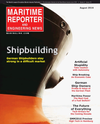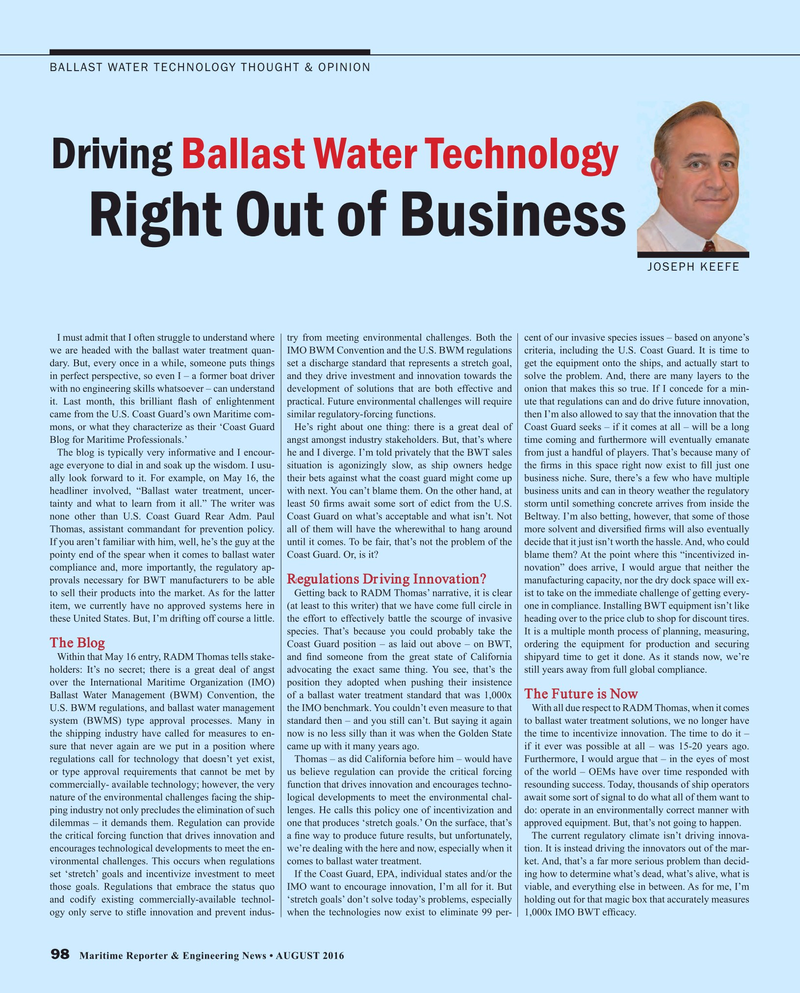
Page 98: of Maritime Reporter Magazine (August 2016)
The Shipyard Edition
Read this page in Pdf, Flash or Html5 edition of August 2016 Maritime Reporter Magazine
BALLAST WATER TECHNOLOGY THOUGHT & OPINION
Driving Ballast Water Technology Right Out of Business
JOSEPH KEEFE
I must admit that I often struggle to understand where try from meeting environmental challenges. Both the cent of our invasive species issues – based on anyone’s we are headed with the ballast water treatment quan- IMO BWM Convention and the U.S. BWM regulations criteria, including the U.S. Coast Guard. It is time to dary. But, every once in a while, someone puts things set a discharge standard that represents a stretch goal, get the equipment onto the ships, and actually start to in perfect perspective, so even I – a former boat driver and they drive investment and innovation towards the solve the problem. And, there are many layers to the with no engineering skills whatsoever – can understand development of solutions that are both effective and onion that makes this so true. If I concede for a min- it. Last month, this brilliant ? ash of enlightenment practical. Future environmental challenges will require ute that regulations can and do drive future innovation, came from the U.S. Coast Guard’s own Maritime com- similar regulatory-forcing functions. then I’m also allowed to say that the innovation that the mons, or what they characterize as their ‘Coast Guard He’s right about one thing: there is a great deal of Coast Guard seeks – if it comes at all – will be a long
Blog for Maritime Professionals.’ angst amongst industry stakeholders. But, that’s where time coming and furthermore will eventually emanate
The blog is typically very informative and I encour- he and I diverge. I’m told privately that the BWT sales from just a handful of players. That’s because many of age everyone to dial in and soak up the wisdom. I usu- situation is agonizingly slow, as ship owners hedge the ? rms in this space right now exist to ? ll just one ally look forward to it. For example, on May 16, the their bets against what the coast guard might come up business niche. Sure, there’s a few who have multiple headliner involved, “Ballast water treatment, uncer- with next. You can’t blame them. On the other hand, at business units and can in theory weather the regulatory tainty and what to learn from it all.” The writer was least 50 ? rms await some sort of edict from the U.S. storm until something concrete arrives from inside the none other than U.S. Coast Guard Rear Adm. Paul Coast Guard on what’s acceptable and what isn’t. Not Beltway. I’m also betting, however, that some of those
Thomas, assistant commandant for prevention policy. all of them will have the wherewithal to hang around more solvent and diversi? ed ? rms will also eventually
If you aren’t familiar with him, well, he’s the guy at the until it comes. To be fair, that’s not the problem of the decide that it just isn’t worth the hassle. And, who could pointy end of the spear when it comes to ballast water Coast Guard. Or, is it? blame them? At the point where this “incentivized in- compliance and, more importantly, the regulatory ap- novation” does arrive, I would argue that neither the
Regulations Driving Innovation?
provals necessary for BWT manufacturers to be able manufacturing capacity, nor the dry dock space will ex- to sell their products into the market. As for the latter Getting back to RADM Thomas’ narrative, it is clear ist to take on the immediate challenge of getting every- item, we currently have no approved systems here in (at least to this writer) that we have come full circle in one in compliance. Installing BWT equipment isn’t like these United States. But, I’m drifting off course a little. the effort to effectively battle the scourge of invasive heading over to the price club to shop for discount tires. species. That’s because you could probably take the It is a multiple month process of planning, measuring,
The Blog Coast Guard position – as laid out above – on BWT, ordering the equipment for production and securing
Within that May 16 entry, RADM Thomas tells stake- and ? nd someone from the great state of California shipyard time to get it done. As it stands now, we’re holders: It’s no secret; there is a great deal of angst advocating the exact same thing. You see, that’s the still years away from full global compliance.
over the International Maritime Organization (IMO) position they adopted when pushing their insistence
Ballast Water Management (BWM) Convention, the of a ballast water treatment standard that was 1,000x The Future is Now
U.S. BWM regulations, and ballast water management the IMO benchmark. You couldn’t even measure to that With all due respect to RADM Thomas, when it comes system (BWMS) type approval processes. Many in standard then – and you still can’t. But saying it again to ballast water treatment solutions, we no longer have the shipping industry have called for measures to en- now is no less silly than it was when the Golden State the time to incentivize innovation. The time to do it – sure that never again are we put in a position where came up with it many years ago. if it ever was possible at all – was 15-20 years ago. regulations call for technology that doesn’t yet exist, Thomas – as did California before him – would have Furthermore, I would argue that – in the eyes of most or type approval requirements that cannot be met by us believe regulation can provide the critical forcing of the world – OEMs have over time responded with commercially- available technology; however, the very function that drives innovation and encourages techno- resounding success. Today, thousands of ship operators nature of the environmental challenges facing the ship- logical developments to meet the environmental chal- await some sort of signal to do what all of them want to ping industry not only precludes the elimination of such lenges. He calls this policy one of incentivization and do: operate in an environmentally correct manner with dilemmas – it demands them. Regulation can provide one that produces ‘stretch goals.’ On the surface, that’s approved equipment. But, that’s not going to happen.
the critical forcing function that drives innovation and a ? ne way to produce future results, but unfortunately, The current regulatory climate isn’t driving innova- encourages technological developments to meet the en- we’re dealing with the here and now, especially when it tion. It is instead driving the innovators out of the mar- vironmental challenges. This occurs when regulations comes to ballast water treatment. ket. And, that’s a far more serious problem than decid- set ‘stretch’ goals and incentivize investment to meet If the Coast Guard, EPA, individual states and/or the ing how to determine what’s dead, what’s alive, what is those goals. Regulations that embrace the status quo IMO want to encourage innovation, I’m all for it. But viable, and everything else in between. As for me, I’m and codify existing commercially-available technol- ‘stretch goals’ don’t solve today’s problems, especially holding out for that magic box that accurately measures ogy only serve to sti? e innovation and prevent indus- when the technologies now exist to eliminate 99 per- 1,000x IMO BWT ef? cacy.
98 Maritime Reporter & Engineering News • AUGUST 2016
MR #8 (98-105).indd 98 8/2/2016 3:34:09 PM

 97
97

 99
99
